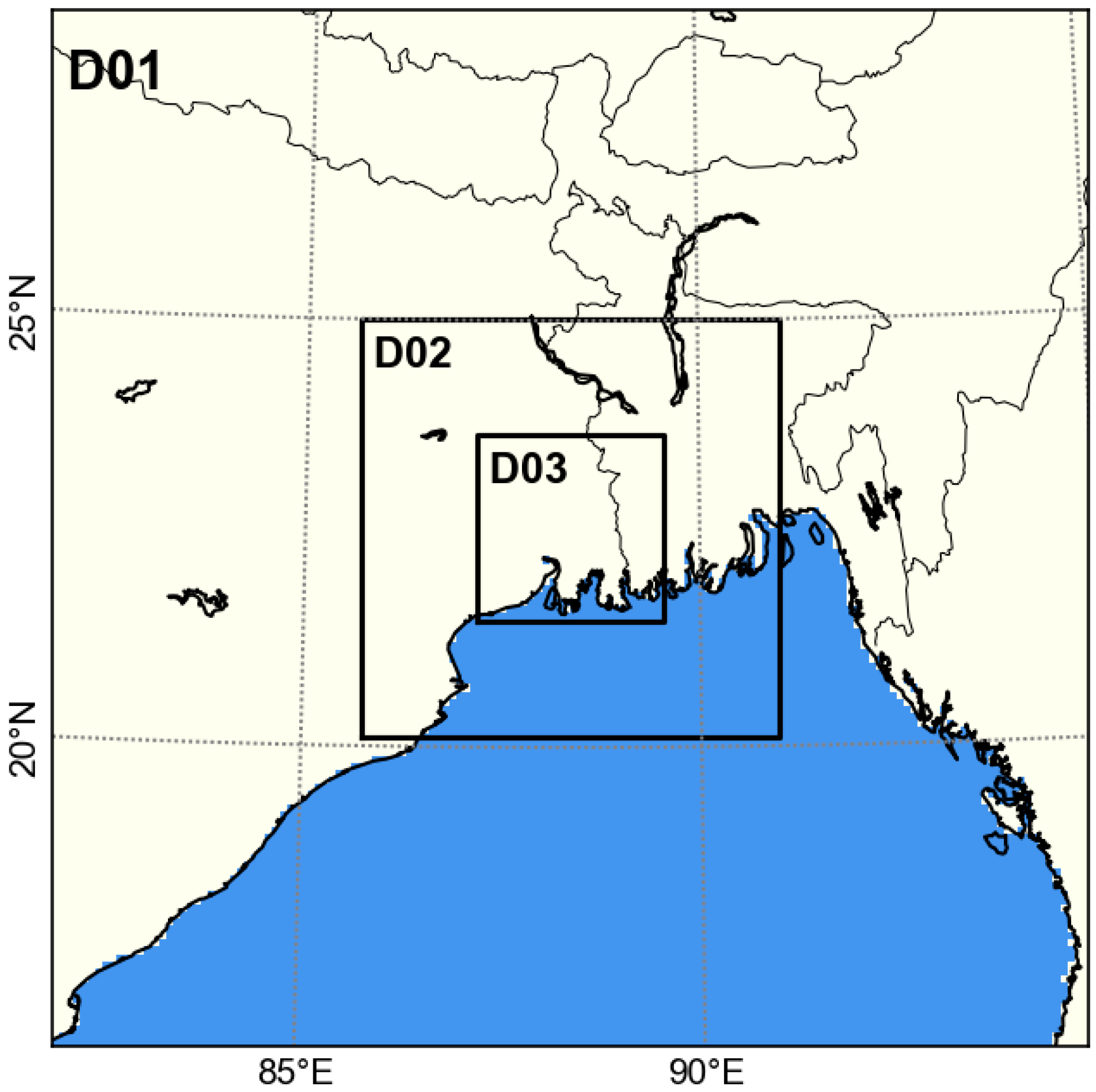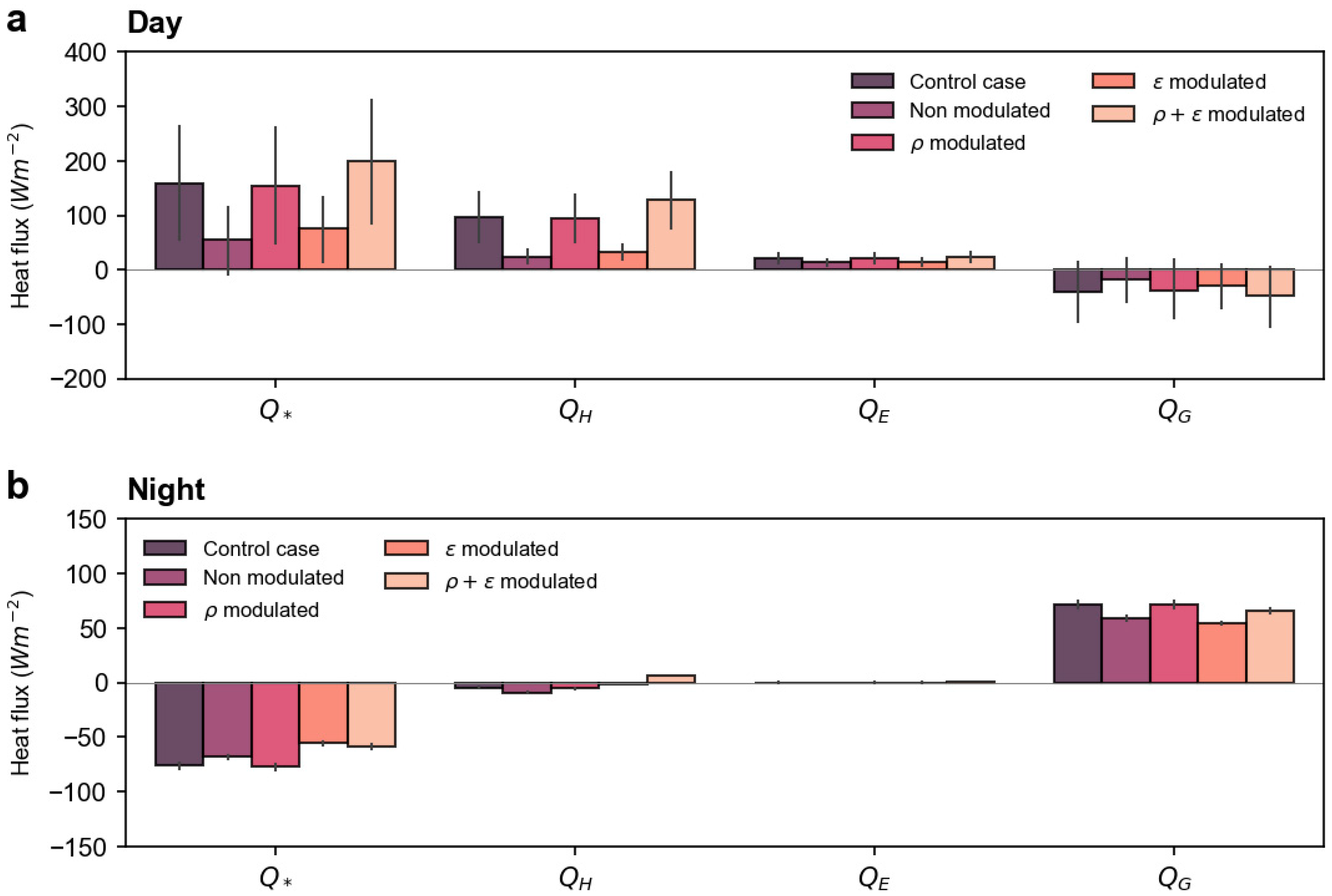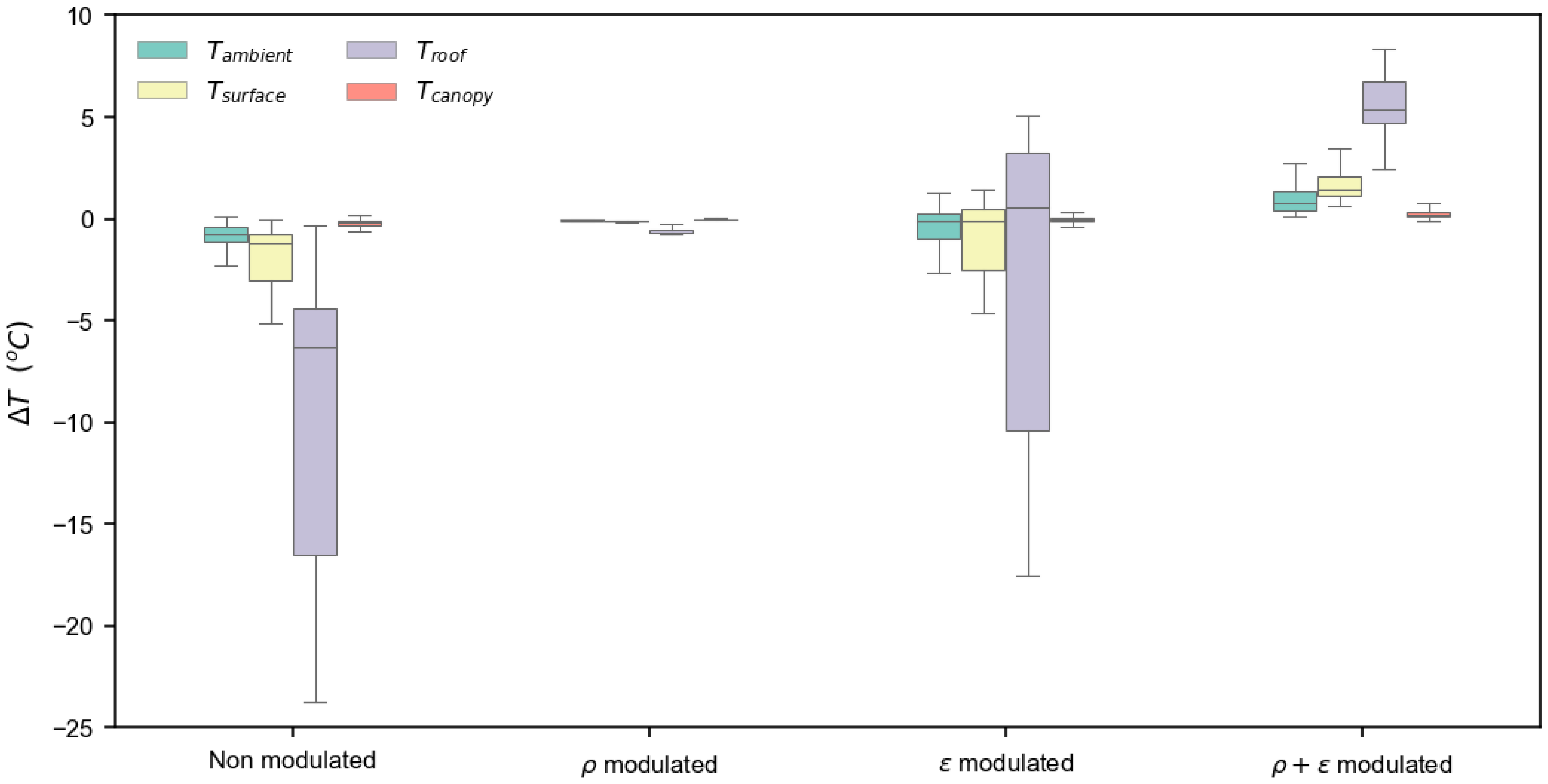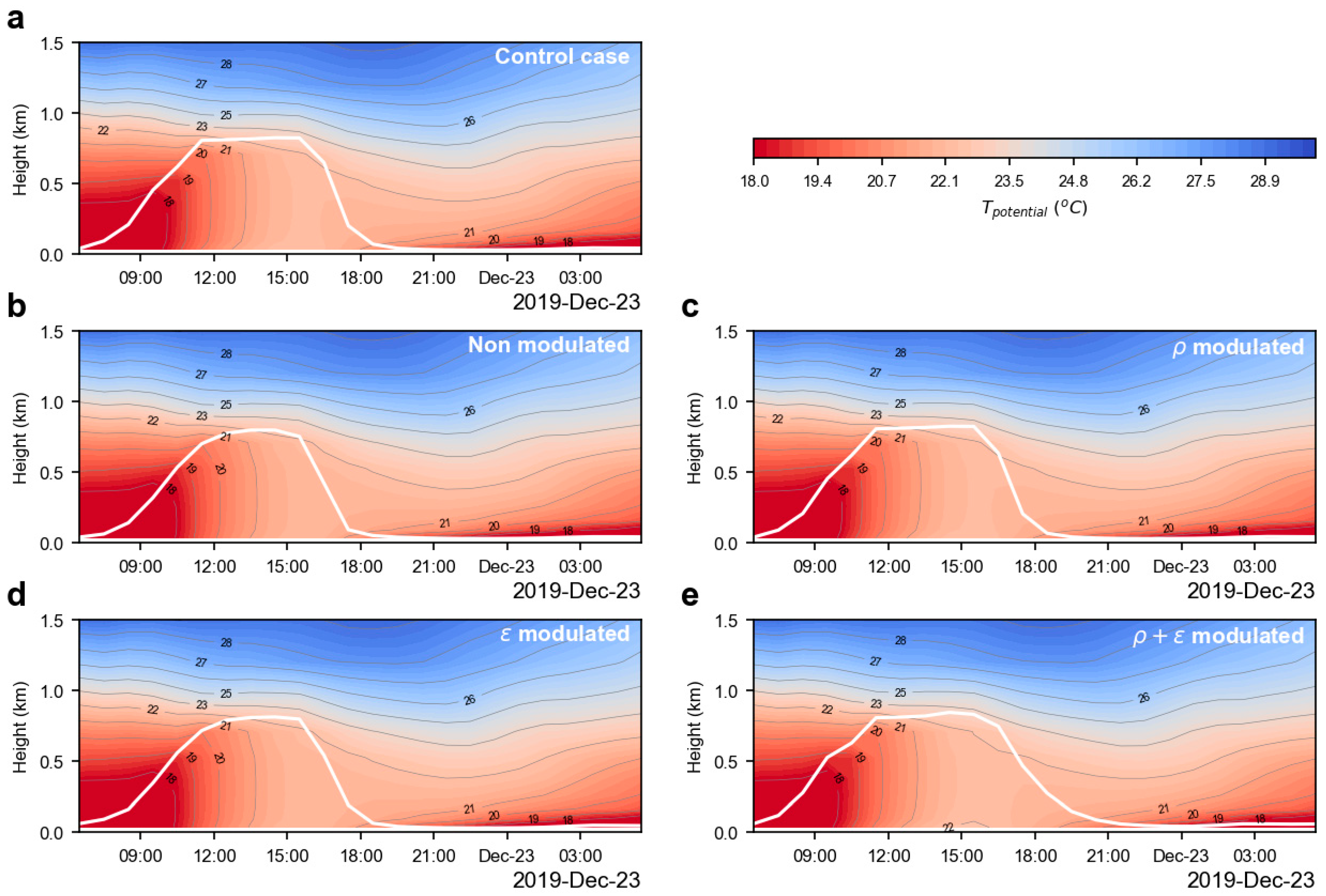Optically Modulated Passive Broadband Daytime Radiative Cooling Materials Can Cool Cities in Summer and Heat Cities in Winter
Abstract
:1. Introduction
1.1. Context
1.2. Optical Modulation of Passive Daytime Radiative Cooling
- What is the impact of modulated and non-modulated PDRC materials on a city scale during the winter period?
- How is the thermal balance maintained to avoid extra heating energy costs?
- Once optical modulation techniques are applied, how much is the overcooling penalty reduced?
- To present and discuss different technologies available to modulate the PDRC materials’ optical characteristics to reduce the overcooling penalty.
- To evaluate the potential to minimize the overcooling penalty in winter using the different optical modulation techniques.
2. Materials and Methods
2.1. Climate and Location Selection
2.2. Model Configuration
2.3. Model Validation and Assessment
2.4. Study Cases: Kolkata Metropolitan Area
3. Results
3.1. The Magnitude of Heat Flux and Net Inflow Radiation
3.1.1. Change of Sensible Heat (QH)
3.1.2. Change of the Latent Heat (QE)
3.1.3. Change of the Net Inflow Radiation (Q*)
3.1.4. Change of the Heat Storage (QG)
3.2. Change of Temperatures
3.2.1. Change of the Magnitude of the Ambient Temperature at 2 m Height (Tambient)
3.2.2. Change in the Magnitude of the Ground Surface Temperature (Tsurface)
3.2.3. Change in the Magnitude of the Roof Surface Temperature (Troof)
3.2.4. Change in the Magnitude of the Urban Canopy Temperature (Tcanopy)
3.3. Impact on the Lower Atmosphere
4. Discussion
5. Conclusions
- Solar reflectance (ρ) or emissivity (ε) modulation of the PDRC materials has insignificant mitigation potential for the overcooling penalty, both during the day and night.
- Reflectivity and emissivity modulated PDRC materials increase their daily maximum latent heat by 182 Wm−2 and their daily maximum heat storage by 244 Wm−2, compared to the non-modulated PDRC materials.
- When both the reflectivity and the emissivity (ρ+ε) are modulated, a positive energy balance occurs during the winter period, as the surface temperature of the materials (Tsurface) may increase up to 0.9 °C compared to the control case. This results in an ambient temperature rise of 0.4 °C and 1.5 °C when compared to the CTRL and the conventional PDRC materials, respectively.
- Optically modulated PDRC materials can be an excellent urban heat mitigation technology for use during the summer period without leading to an overcooling penalty during the winter.
Author Contributions
Funding
Institutional Review Board Statement
Data Availability Statement
Conflicts of Interest
References
- Founda, D.; Santamouris, M. Synergies between Urban Heat Island and Heat Waves in Athens (Greece), during an Extremely Hot Summer (2012). Sci. Rep. 2017, 7, 10973. [Google Scholar] [CrossRef] [PubMed] [Green Version]
- Santamouris, M. Innovating to Zero the Building Sector in Europe: Minimising the Energy Consumption, Eradication of the Energy Poverty and Mitigating the Local Climate Change. Sol. Energy 2016, 128, 61–94. [Google Scholar] [CrossRef]
- Santamouris, M. Analyzing the Heat Island Magnitude and Characteristics in One Hundred Asian and Australian Cities and Regions. Sci. Total Environ. 2015, 512–513, 582–598. [Google Scholar] [CrossRef] [PubMed]
- Santamouris, M. Recent Progress on Urban Overheating and Heat Island Research. Integrated Assessment of the Energy, Environmental, Vulnerability and Health Impact. Synergies with the Global Climate Change. Energy Build. 2020, 207, 109482. [Google Scholar] [CrossRef]
- Santamouris, M. On the Energy Impact of Urban Heat Island and Global Warming on Buildings. Energy Build. 2014, 82, 100–113. [Google Scholar] [CrossRef]
- Santamouris, M.; Cartalis, C.; Synnefa, A.; Kolokotsa, D. On the Impact of Urban Heat Island and Global Warming on the Power Demand and Electricity Consumption of Buildings—A Review. Energy Build. 2015, 98, 119–124. [Google Scholar] [CrossRef]
- Shishegar, N. Street Design and Urban Microclimate: Analyzing the Effects of Street Geometry and Orientation on Airflowand Solar Access in Urban Canyons. J. Clean Energy Technol. 2013, 1, 52–56. [Google Scholar] [CrossRef]
- Oliveira Panão, M.J.N.; Gonçalves, H.J.P.; Ferrão, P.M.C. Numerical Analysis of the Street Canyon Thermal Conductance to Improve Urban Design and Climate. Build. Environ. 2009, 44, 177–187. [Google Scholar] [CrossRef]
- Georgakis, C.; Santamouris, M. Experimental Investigation of Air Flow and Temperature Distribution in Deep Urban Canyons for Natural Ventilation Purposes. Energy Build. 2006, 38, 367–376. [Google Scholar] [CrossRef]
- Akbari, H.; Cartalis, C.; Kolokotsa, D.; Muscio, A.; Pisello, A.L.; Rossi, F.; Santamouris, M.; Synnefa, A.; Wong, N.H.; Zinzi, M. Local Climate Change and Urban Heat Island Mitigation Techniques—The State of the Art. J. Civ. Eng. Manag. 2016, 22, 1–16. [Google Scholar] [CrossRef] [Green Version]
- Santamouris, M.; Yun, G.Y. Recent Development and Research Priorities on Cool and Super Cool Materials to Mitigate Urban Heat Island. Renew. Energy 2020, 161, 792–807. [Google Scholar] [CrossRef]
- Santamouris, M.; Feng, J. Recent Progress in Daytime Radiative Cooling: Is It the Air Conditioner of the Future? Buildings 2018, 8, 168. [Google Scholar] [CrossRef] [Green Version]
- Raman, A.P.; Anoma, M.A.; Zhu, L.; Rephaeli, E.; Fan, S. Passive Radiative Cooling below Ambient Air Temperature under Direct Sunlight. Nature 2014, 515, 540–544. [Google Scholar] [CrossRef] [PubMed]
- Hossain, M.M.; Jia, B.; Gu, M. A Metamaterial Emitter for Highly Efficient Radiative Cooling. Adv. Opt. Mater. 2015, 3, 1047–1051. [Google Scholar] [CrossRef]
- Kecebas, M.A.; Menguc, M.P.; Kosar, A.; Sendur, K. Passive Radiative Cooling Design with Broadband Optical Thin-Film Filters. J. Quant. Spectrosc. Radiat. Transf. 2017, 198, 179–186. [Google Scholar] [CrossRef]
- Wu, D.; Liu, C.; Xu, Z.; Liu, Y.; Yu, Z.; Yu, L.; Chen, L.; Li, R.; Ma, R.; Ye, H. The Design of Ultra-Broadband Selective near-Perfect Absorber Based on Photonic Structures to Achieve near-Ideal Daytime Radiative Cooling. Mater. Des. 2018, 139, 104–111. [Google Scholar] [CrossRef]
- Atiganyanun, S.; Plumley, J.B.; Han, S.J.; Hsu, K.; Cytrynbaum, J.; Peng, T.L.; Han, S.M.; Han, S.E. Effective Radiative Cooling by Paint-Format Microsphere-Based Photonic Random Media. ACS Photonics 2018, 5, 1181–1187. [Google Scholar] [CrossRef]
- Aili, A.; Wei, Z.; Chen, Y.; Zhao, D.; Yang, R.; Yin, X. Selection of Polymers with Functional Groups for Day-Time Radiative Cooling. Mater. Today Phys. 2019, 10, 100127. [Google Scholar] [CrossRef]
- Zhai, Y.; Ma, Y.; David, S.N.; Zhao, D.; Lou, R.; Tan, G.; Yang, R.; Yin, X. Scalable-Manufactured Randomized Glass-Polymer Hybrid Metamaterial for Daytime Radiative Cooling. Science 2017, 355, 1062–1066. [Google Scholar] [CrossRef] [PubMed] [Green Version]
- Carlosena, L.; Andueza, Á.; Torres, L.; Irulegi, O.; Hernández-Minguillón, R.J.; Sevilla, J.; Santamouris, M. Experimental Development and Testing of Low-Cost Scalable Radiative Cooling Materials for Building Applications. Sol. Energy Mater. Sol. Cells 2021, 230, 111209. [Google Scholar] [CrossRef]
- Mandal, J.; Fu, Y.; Overvig, A.; Jia, M.; Sun, K.; Shi, N.; Zhou, H.; Xiao, X.; Yu, N.; Yang, Y. Hierarchically Porous Polymer Coatings for Highly Efficient Passive Daytime Radiative Cooling. Science 2018, 362, 315–319. [Google Scholar] [CrossRef] [PubMed] [Green Version]
- Ao, X.; Hu, M.; Zhao, B.; Chen, N.; Pei, G.; Zou, C. Preliminary Experimental Study of a Specular and a Diffuse Surface for Daytime Radiative Cooling. Sol. Energy Mater. Sol. Cells 2019, 191, 290–296. [Google Scholar] [CrossRef]
- Feng, J.; Gao, K.; Santamouris, M.; Shah, K.W.; Ranzi, G. Dynamic Impact of Climate on the Performance of Daytime Radiative Cooling Materials. Sol. Energy Mater. Sol. Cells 2020, 208, 110426. [Google Scholar] [CrossRef]
- Yin, X.; Yang, R.; Tan, G.; Fan, S. Terrestrial Radiative Cooling: Using the Cold Universe as a Renewable and Sustainable Energy Source. Science 2020, 370, 786–791. [Google Scholar] [CrossRef] [PubMed]
- Bartesaghi-Koc, C.; Haddad, S.; Pignatta, G.; Paolini, R.; Prasad, D.; Santamouris, M. Can Urban Heat Be Mitigated in a Single Urban Street? Monitoring, Strategies, and Performance Results from a Real Scale Redevelopment Project. Sol. Energy 2021, 216, 564–588. [Google Scholar] [CrossRef]
- Baniassadi, A.; Heusinger, J.; Sailor, D.J. Building Energy Savings Potential of a Hybrid Roofing System Involving High Albedo, Moisture Retaining Foam Materials. Energy Build. 2018, 169, 283–294. [Google Scholar] [CrossRef]
- Khan, A.; Carlosena, L.; Khorat, S.; Khatun, R.; Doan, Q.-V.; Feng, J.; Santamouris, M. On the Winter Overcooling Penalty of Super Cool Photonic Materials in Cities. Sol. Energy Adv. 2021, 1, 100009. [Google Scholar] [CrossRef]
- Ji, H.; Liu, D.; Cheng, H.; Zhang, C.; Yang, L. Vanadium Dioxide Nanopowders with Tunable Emissivity for Adaptive Infrared Camouflage in Both Thermal Atmospheric Windows. Sol. Energy Mater. Sol. Cells 2018, 175, 96–101. [Google Scholar] [CrossRef]
- Ono, M.; Chen, K.; Li, W.; Fan, S. Self-Adaptive Radiative Cooling Based on Phase Change Materials. Opt. Express 2018, 26, A777. [Google Scholar] [CrossRef] [PubMed]
- Lang, F.; Wang, H.; Zhang, S.; Liu, J.; Yan, H. Review on Variable Emissivity Materials and Devices Based on Smart Chromism. Int. J. Thermophys. 2017, 39, 6. [Google Scholar] [CrossRef]
- Jorgenson, G.V.; Lee, J.C. Doped Vanadium Oxide for Optical Switching Films. Sol. Energy Mater. 1986, 14, 205–214. [Google Scholar] [CrossRef]
- Tazawa, M.; Jin, P.; Tanemura, S. Thin Film Used to Obtain a Constant Temperature Lower than the Ambient. Thin Solid Films 1996, 281–282, 232–234. [Google Scholar] [CrossRef]
- Santos, A.J.; Lacroix, B.; Domínguez, M.; García, R.; Martin, N.; Morales, F.M. Controlled Grain-Size Thermochromic VO2 Coatings by the Fast Oxidation of Sputtered Vanadium or Vanadium Oxide Films Deposited at Glancing Angles. Surf. Interfaces 2021, 27, 101581. [Google Scholar] [CrossRef]
- Li, B.; Yao, J.; Tian, S.; Fang, Z.; Wu, S.; Liu, B.; Gong, X.; Tao, H.; Zhao, X. A Facile One-Step Annealing Route to Prepare Thermochromic W Doped VO2(M) Particles for Smart Windows. Ceram. Int. 2020, 46, 18274–18280. [Google Scholar] [CrossRef]
- Nazari, S.; Charpentier, P.A. Sol-Gel Processing of VO2 (M) in Supercritical CO2 and Supercritical CO2/Ionic Liquid Biphasic System. J. Supercrit. Fluids 2020, 165, 104989. [Google Scholar] [CrossRef]
- Zhao, X.P.; Mofid, S.A.; Gao, T.; Tan, G.; Jelle, B.P.; Yin, X.B.; Yang, R.G. Durability-Enhanced Vanadium Dioxide Thermochromic Film for Smart Windows. Mater. Today Phys. 2020, 13, 100205. [Google Scholar] [CrossRef]
- Zhao, Z.; Liu, Y.; Wang, D.; Ling, C.; Chang, Q.; Li, J.; Zhao, Y.; Jin, H. Sn Dopants Improve the Visible Transmittance of VO2 Films Achieving Excellent Thermochromic Performance for Smart Window. Sol. Energy Mater. Sol. Cells 2020, 209, 110443. [Google Scholar] [CrossRef]
- Granqvist, C.G.; Lansåker, P.C.; Mlyuka, N.R.; Niklasson, G.A.; Avendaño, E. Progress in Chromogenics: New Results for Electrochromic and Thermochromic Materials and Devices. Sol. Energy Mater. Sol. Cells 2009, 93, 2032–2039. [Google Scholar] [CrossRef]
- Kanu, S.S.; Binions, R. Thin Films for Solar Control Applications. Proc. R. Soc. Math. Phys. Eng. Sci. 2010, 466, 19–44. [Google Scholar] [CrossRef] [Green Version]
- Perez, G.; Allegro, V.R.; Corroto, M.; Pons, A.; Guerrero, A. Smart Reversible Thermochromic Mortar for Improvement of Energy Efficiency in Buildings. Constr. Build. Mater. 2018, 186, 884–891. [Google Scholar] [CrossRef]
- Wong, R.Y.M.; Tso, C.Y.; Chao, C.Y.H.; Huang, B.; Wan, M.P. Ultra-Broadband Asymmetric Transmission Metallic Gratings for Subtropical Passive Daytime Radiative Cooling. Sol. Energy Mater. Sol. Cells 2018, 186, 330–339. [Google Scholar] [CrossRef]
- Mandal, J.; Du, S.; Dontigny, M.; Zaghib, K.; Yu, N.; Yang, Y. Li4Ti5O12: A Visible-to-Infrared Broadband Electrochromic Material for Optical and Thermal Management. Adv. Funct. Mater. 2018, 28, 1802180. [Google Scholar] [CrossRef] [Green Version]
- Mandal, J.; Jia, M.; Overvig, A.; Fu, Y.; Che, E.; Yu, N.; Yang, Y. Porous Polymers with Switchable Optical Transmittance for Optical and Thermal Regulation. Joule 2019, 3, 3088–3099. [Google Scholar] [CrossRef]
- Tang, K.; Dong, K.; Li, J.; Gordon, M.P.; Reichertz, F.G.; Kim, H.; Rho, Y.; Wang, Q.; Lin, C.-Y.; Grigoropoulos, C.P.; et al. Temperature-Adaptive Radiative Coating for All-Season Household Thermal Regulation. Science 2021, 374, 1504–1509. [Google Scholar] [CrossRef] [PubMed]
- Xue, X.; Qiu, M.; Li, Y.; Zhang, Q.M.; Li, S.; Yang, Z.; Feng, C.; Zhang, W.; Dai, J.-G.; Lei, D.; et al. Creating an Eco-Friendly Building Coating with Smart Subambient Radiative Cooling. Adv. Mater. 2020, 32, 1906751. [Google Scholar] [CrossRef]
- Wang, S.; Jiang, T.; Meng, Y.; Yang, R.; Tan, G.; Long, Y. Scalable Thermochromic Smart Windows with Passive Radiative Cooling Regulation. Science 2021, 374, 1501–1504. [Google Scholar] [CrossRef] [PubMed]
- IPCC. Climate Change 2021: The Physical Science Basis. Contribution of Working Group I to the Sixth Assessment Report of the Intergovernmental Panel on Climate Change; Masson-Delmotte, V., Zhai, P., Pirani, A., Connors, S.L., Péan, C., Berger, S., Caud, N., Chen, Y., Goldfarb, L., Gomis, M.I., et al., Eds.; Cambridge University Press: Cambridge, MA, USA; Cambridge, UK, in press.
- Dhorde, A. Long-Term Temperature Trends at Four Largest Cities of India during the Twentieth Century. J. Ind. Geophys. Union 2009, 13, 85–97. [Google Scholar]
- Kothawale, D.R.; Deshpande, N.R.; Kolli, R.K. Long Term Temperature Trends at Major, Medium, Small Cities and Hill Stations in India during the Period 1901–2013. Am. J. Clim. Chang. 2016, 5, 383–398. [Google Scholar] [CrossRef] [Green Version]
- Feng, J.; Khan, A.; Doan, Q.-V.; Gao, K.; Santamouris, M. The Heat Mitigation Potential and Climatic Impact of Super-Cool Broadband Radiative Coolers on a City Scale. Cell Rep. Phys. Sci. 2021, 2, 100485. [Google Scholar] [CrossRef]
- Skamarock, W.C.; Klemp, J.B.; Dudhia, J.; Gill, D.O.; Liu, Z.; Berner, J.; Wang, W.; Powers, J.G.; Duda, M.G.; Barker, D.M.; et al. A Description of the Advanced Research WRF Model Version 4; UCAR/NCAR; National Center for Atmospheric Research: Boulder, CO, USA, 2019. [Google Scholar]
- Chen, F.; Kusaka, H.; Bornstein, R.; Ching, J.; Grimmond, C.S.B.; Grossman-Clarke, S.; Loridan, T.; Manning, K.W.; Martilli, A.; Miao, S.; et al. The Integrated WRF/Urban Modelling System: Development, Evaluation, and Applications to Urban Environmental Problems. Int. J. Climatol. 2011, 31, 273–288. [Google Scholar] [CrossRef]
- Kusaka, H.; Kondo, H.; Kikegawa, Y.; Kimura, F. A Simple Single-Layer Urban Canopy Model For Atmospheric Models: Comparison With Multi-Layer And Slab Models. Bound.-Layer Meteorol. 2001, 101, 329–358. [Google Scholar] [CrossRef]
- Dudhia, J. Numerical Study of Convection Observed during the Winter Monsoon Experiment Using a Mesoscale Two-Dimensional Model. J. Atmos. Sci. 1989, 46, 3077–3107. [Google Scholar] [CrossRef]
- Mlawer, E.J.; Taubman, S.J.; Brown, P.D.; Iacono, M.J.; Clough, S.A. Radiative Transfer for Inhomogeneous Atmospheres: RRTM, a Validated Correlated-k Model for the Longwave. J. Geophys. Res. Atmos. 1997, 102, 16663–16682. [Google Scholar] [CrossRef] [Green Version]
- Lin, Y.-L.; Farley, R.D.; Orville, H.D. Bulk Parameterization of the Snow Field in a Cloud Model. J. Appl. Meteorol. Climatol. 1983, 22, 1065–1092. [Google Scholar] [CrossRef] [Green Version]
- Mellor, G.L.; Yamada, T. A hierarchy of turbulence closure models for planetary boundary layers. J. Atmos. Sci. 1974, 31, 1791–1806. [Google Scholar] [CrossRef] [Green Version]
- Kain, J.S. The Kain–Fritsch Convective Parameterization: An Update. J. Appl. Meteorol. Climatol. 2004, 43, 170–181. [Google Scholar] [CrossRef] [Green Version]
- Pleim, J.E. A Combined Local and Nonlocal Closure Model for the Atmospheric Boundary Layer. Part I: Model Description and Testing. J. Appl. Meteorol. Climatol. 2007, 46, 1383–1395. [Google Scholar] [CrossRef]
- Karlessi, T.; Santamouris, M. Improving the Performance of Thermochromic Coatings with the Use of UV and Optical Filters Tested under Accelerated Aging Conditions. Int. J. Low-Carbon Technol. 2013, 10, 45–61. [Google Scholar] [CrossRef]
- Carlosena, L.; Ruiz-Pardo, Á.; Feng, J.; Irulegi, O.; Hernández-Minguillón, R.J.; Santamouris, M. On the Energy Potential of Daytime Radiative Cooling for Urban Heat Island Mitigation. Sol. Energy 2020, 208, 430–444. [Google Scholar] [CrossRef]
- Leroy, A.; Bhatia, B.; Kelsall, C.C.; Castillejo-Cuberos, A.; Di Capua H, M.; Zhao, L.; Zhang, L.; Guzman, A.M.; Wang, E.N. High-Performance Subambient Radiative Cooling Enabled by Optically Selective and Thermally Insulating Polyethylene Aerogel. Sci. Adv. 2019, 5, eaat9480. [Google Scholar] [CrossRef] [Green Version]
- Zhao, D.; Aili, A.; Zhai, Y.; Xu, S.; Tan, G.; Yin, X.; Yang, R. Radiative Sky Cooling: Fundamental Principles, Materials, and Applications. Appl. Phys. Rev. 2019, 6, 021306. [Google Scholar] [CrossRef]





| Parameters | Local Meteorological Station | |||||
|---|---|---|---|---|---|---|
| Alipore | Ratan Babu Ghat | Shibpur | Palmer Bridge | Jora Bridge | Joka | |
| Correlation coefficient | 0.8165 | 0.9687 | 0.9422 | 0.8634 | 0.8216 | 0.9326 |
| Mean bias error | −2.1 | −0.34 | −0.89 | −1.0 | 0.05 | −0.54 |
| Mean absolute error | −2.1082 | −0.3385 | −0.8889 | −1.044 | 0.0454 | −0.5429 |
| Root mean square error | 2.9 | 0.8 | 1.4 | 1.9 | 2.0 | 1.4 |
| Index of agreement | 0.81 | 0.98 | 0.95 | 0.90 | 0.89 | 0.95 |
| Numerical Design | Type of Roof | Scenario | Optical Properties of the Material | |
|---|---|---|---|---|
| Reflectance (ρ) | Emissivity (ε) | |||
| Control case (CTRL) | Conventional | Control scenario | Roof 0.20 | Roof 0.85 |
| Wall 0.20 | Wall 0.85 | |||
| Ground (road) 0.20 | Ground (road) 0.85 | |||
| Non-modulated (nm-PDRC) | Standard PDRC roof | Scenario 1 | Roof 0.95 | Roof 0.93 |
| Wall 0.20 | Wall 0.85 | |||
| Ground(road) 0.20 | Ground (road) 0.85 | |||
| Reflectance modulated (ρ-PDRC) | ρ-modulated PDRC roof | Scenario 2 | Roof 0.20 | Roof 0.93 |
| Wall 0.20 | Wall 0.85 | |||
| Ground(road) 0.20 | Ground (road) 0.85 | |||
| Emissivity modulated (ε-PDRC) | ε-modulated PDRC roof | Scenario 3 | Roof 0.95 | Roof 0.20 |
| Wall 0.20 | Wall 0.85 | |||
| Ground(road) 0.20 | Ground (road) 0.85 | |||
| Reflectance and emissivity modulated (ρ+ε-PDRC) | ρ+ε-modulated PDRC roof | Scenario 4 | Roof 0.20 | Roof 0.20 |
| Wall 0.20 | Wall 0.85 | |||
| Ground(road) 0.20 | Ground (road) 0.85 | |||
| Heat Flux (Wm−2) | CTRL | nm-PDRC | ρ-PDRC | ε-PDRC | ρ+ε-PDRC | |
|---|---|---|---|---|---|---|
| QH | Day max. | 188.5 | 51.0 | 183.8 | 61.1 | 233.1 |
| Night max. | −1.1 | −3.6 | −1.5 | 2.0 | 6.4 | |
| Day avg. | 94.1 | 23.7 | 91.1 | 31.4 | 112.8 | |
| Night avg. | −3.0 | −6.4 | −3.5 | −1.0 | 5.2 | |
| QE | Day max. | 58.5 | 44.6 | 58.4 | 45.1 | 59.8 |
| Night max. | 18.2 | 18.3 | 18.2 | 16.8 | 16.8 | |
| Day avg. | 36.6 | 28.4 | 36.5 | 29.3 | 37.9 | |
| Night avg. | 0.5 | 0.6 | 0.6 | 0.7 | 0.9 | |
| QG | Day max. | 86.5 | 70.9 | 87.6 | 59.9 | 78.7 |
| Night max. | 76.8 | 61.6 | 77.7 | 54.1 | 66.2 | |
| Day avg. | −41.6 | −20.4 | −40.9 | −29.8 | −48.7 | |
| Night avg. | 61.8 | 51.1 | 62.2 | 46.2 | 55.4 | |
| QE | Day max. | 385.4 | 192.7 | 380.0 | 211.7 | 436.9 |
| Night max. | −37.7 | −33.7 | −38.4 | −25.5 | −28.5 | |
| Day avg. | 170.4 | 72.6 | 166.5 | 90.6 | 208.4 | |
| Night avg. | −73.9 | −66.4 | −74.9 | −52.2 | −56.4 | |
| Temperature (°C) | CTRL | nm-PDRC | ρ-PDRC | ε-PDRC | ρ+ε-PDRC | |
|---|---|---|---|---|---|---|
| Tambient | Day max. | 24.2 | 23.1 | 24.2 | 23.3 | 24.6 |
| Night max. | 21.5 | 20.7 | 21.5 | 21.3 | 22.9 | |
| Day avg. | 21.1 | 20.1 | 21.1 | 20.4 | 21.6 | |
| Night avg. | 17.9 | 17.3 | 17.8 | 18.0 | 19.2 | |
| Tsurface | Day max. | 27.0 | 23.8 | 26.9 | 24.1 | 27.9 |
| Night max. | 21.2 | 20.1 | 21.1 | 21.0 | 22.9 | |
| Day avg. | 23.0 | 20.8 | 22.9 | 21.3 | 24.0 | |
| Night avg. | 17.8 | 17.0 | 17.7 | 18.1 | 19.7 | |
| Troof | Day max. | 35.7 | 16.4 | 35.3 | 21.8 | 40.0 |
| Night max. | 19.6 | 13.4 | 19.0 | 19.7 | 24.8 | |
| Day avg. | 27.7 | 15.0 | 27.2 | 20.0 | 31.5 | |
| Night avg. | 15.6 | 11.2 | 15.0 | 18.0 | 21.6 | |
| Tcanopy | Day max. | 30.9 | 30.7 | 30.9 | 30.8 | 31.0 |
| Night max. | 22.8 | 22.5 | 22.8 | 22.7 | 23.0 | |
| Day avg. | 25.5 | 25.3 | 25.5 | 25.2 | 25.6 | |
| Night avg. | 18.9 | 18.7 | 18.9 | 19.0 | 19.3 | |
| Tair | Day max. | 23.3 | 23.0 | 23.0 | 23.0 | 23.4 |
| Night max. | 22.3 | 21.5 | 22.1 | 22.1 | 22.8 | |
| Day avg. | 20.4 | 19.8 | 20.0 | 20.0 | 20.6 | |
| Night avg. | 18.5 | 18.0 | 18.6 | 18.6 | 19.5 | |
Publisher’s Note: MDPI stays neutral with regard to jurisdictional claims in published maps and institutional affiliations. |
© 2022 by the authors. Licensee MDPI, Basel, Switzerland. This article is an open access article distributed under the terms and conditions of the Creative Commons Attribution (CC BY) license (https://creativecommons.org/licenses/by/4.0/).
Share and Cite
Khan, A.; Carlosena, L.; Feng, J.; Khorat, S.; Khatun, R.; Doan, Q.-V.; Santamouris, M. Optically Modulated Passive Broadband Daytime Radiative Cooling Materials Can Cool Cities in Summer and Heat Cities in Winter. Sustainability 2022, 14, 1110. https://doi.org/10.3390/su14031110
Khan A, Carlosena L, Feng J, Khorat S, Khatun R, Doan Q-V, Santamouris M. Optically Modulated Passive Broadband Daytime Radiative Cooling Materials Can Cool Cities in Summer and Heat Cities in Winter. Sustainability. 2022; 14(3):1110. https://doi.org/10.3390/su14031110
Chicago/Turabian StyleKhan, Ansar, Laura Carlosena, Jie Feng, Samiran Khorat, Rupali Khatun, Quang-Van Doan, and Mattheos Santamouris. 2022. "Optically Modulated Passive Broadband Daytime Radiative Cooling Materials Can Cool Cities in Summer and Heat Cities in Winter" Sustainability 14, no. 3: 1110. https://doi.org/10.3390/su14031110
APA StyleKhan, A., Carlosena, L., Feng, J., Khorat, S., Khatun, R., Doan, Q.-V., & Santamouris, M. (2022). Optically Modulated Passive Broadband Daytime Radiative Cooling Materials Can Cool Cities in Summer and Heat Cities in Winter. Sustainability, 14(3), 1110. https://doi.org/10.3390/su14031110







